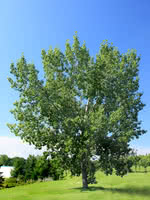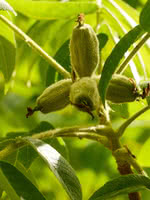Mon-Fri 9am - 5pm Mountain time
Balsam Poplar vs Butternut (White Walnut)
Populus balsamifera
Juglans cinerea
Balsam Poplar is a hardy, fast-growing deciduous tree that is Native to Canada east of the Rockies.
We grow them in two variations. Sometimes they are a male clones, so they don't produce fluff. Other times, we grow them from seed, which will result in fluff. The detailed descriptions (see below) will tell you which is which.
Butternut is one of the few walnut varieties native to Canada. The nuts are sought after for their mild, sweet, and oily taste. Ensure this tree is planted in full sun and well-drained soil for best results.
Butternut is self-fertile but it has better yields when planted near other butternuts. It can survive in zone 2, but reliably produces nuts in zone 3.
A top CO2 absorbing species. Experts think this tree may help climate change more than others.
Balsam Poplar Quick Facts
Butternut (White Walnut) Quick Facts
In row spacing: 2.4 - 3 m (8 - 10 ft)

